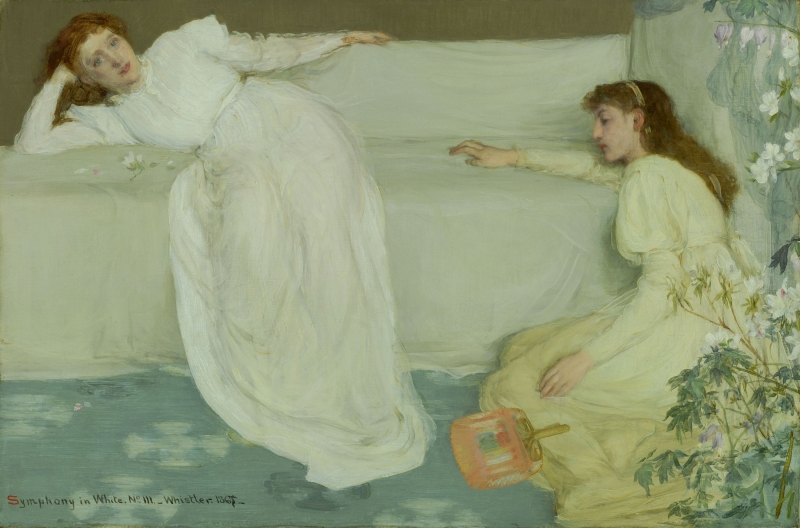Symphony in White, No. 3 was originally signed and dated 1865, the date being later altered to 1867. 1 It may then have been worked on occasionally until 1873.
1865: Joanna Hiffernan (b. ca 1843-d.1886) posed for this painting, and appears in the Sketch of 'Symphony in White No. 3' [M.0323], sent by Whistler in a letter to Ignace-Henri-Jean-Théodore Fantin-Latour (1836-1904) on 16 August 1865:
'... c'est surtout la composition qui m'occupe voici ou j'en suis
fond gris très fin [sketch:] canapé blanc / bleu clair tres fin
[to left of sketch:] Jo en robe de toile très blanc, la même robe que la fille blanche d'autrefois - cette figure est tout ce que j'ai fait de plus pur - tête charmante. Le corps, les jambes, etc., se voient parfaitement à travers la robe
[to right of sketch:] tête blonde, robe de soie blanche jaunatre - ce que l'on appelle foulard - quelque fleurs pourpre foncé tombées par terre près la robe jaunâtre.' 2
[Translation:] '... it is above all the composition that occupies me this is where I have got to
very delicate grey background / [sketch:] white couch / very delicate light blue
[to left of sketch:] Jo in a very white linen dress, the same dress as the white girl earlier - the figure is the purest I have done - charming head. The body, legs, etc., can be seen perfectly through the dress
[to right of sketch:] fair hair, yellowish white silk dress - what is known as foulard - some dark purple flowers on the ground next to the yellowish dress.'
It is possible that Whistler borrowed a 'Chinese blue and white [rug]' from Dante Gabriel Rossetti (1828-1882) to include in this picture. 3
In November 1865 Whistler's mother Anna Matilda Whistler (1804-1881) wrote to him, 'I hope you may add to the Sofa as many beautiful touches as you did to the little white girl & that Houth [sic] may be so charmed he may add more of Whistlers to his own collection.' 4 This suggests that Louis Huth (1821-1905) bought it before it was completed.
1866: On 17 January, shortly before he left for Valparaiso, Whistler begged one of the models, the 16 year old Emelie 'Millie' Eyre Jones (1850-1920), to 'sit again for a few days', possibly for this painting, as 'the picture is wanted at once.' 5
1867: In February Whistler wrote to the Belgian artist Alfred Émile-Léopold Stevens (1823-1906) describing a painting, probably Symphony in White, No. 3 [YMSM 061], which was being taken to Paris:
'Mon frère raporte avec lui le petit tableau - je serai bien aise de le savoir dans le salon du Club ... j'aimerai bien avoir de vous un petit mot pour me dire si il vous plait - Vous verrez bien que j'ai encore quelques petites choses à faire pour entièrement l'achever - les mains ne sont qu'indiquées - je toucherai aussi plus tard aux fleurs -
Mais comme tableau, ensemble, etc., c'est assez pour être vu par les artistes.' 6
Translation: 'My brother is bringing the little painting with him. I would be very glad to know that it was in the salon of the Club. ... I would very much like to have a little word from you to tell me if you like it. You will clearly see that I still have little things to do to complete it altogether - the hands are only sketched in - I shall also touch up the flowers later.
But as a painting, composition, etc., it's enough for it to be seen by artists.'
This implies that Whistler was still working on Symphony in White, No. 3.
It was almost certainly at this time, in February 1867 in Paris, that Hilaire-Germain-Edgar Degas (1834-1917) made a rough sketch of the composition in a notebook. 7
On 31 March 1867 William Michael Rossetti (1829-1919) called in to see what Whistler intended to send to the Royal Academy in May, and discovered that 'he means to send Symphony in White No. 3 (heretofore named The Two Little White Girls).' 8 To this end, the original date of '1865' on the painting was changed to '1867'. A comparison of the present state of the oil with an early photograph (Lucas Collection, Baltimore) taken before the date was changed, shows several minor alterations, which could date from early 1867, before the oil was exhibited at the RA.
It was exhibited at the 99th Exhibition of the Royal Academy of Arts, London, 1867 (cat. no. 233) as 'Symphony in White No. 3'.
1868: In February and March 1868 one of the models, either Emelie 'Millie' Eyre Jones (1850-1920) or her sister Augusta Maria Jones (1843-1902), was still posing for Whistler, possibly for this oil, at the studio of Frederick Jameson (1839-1916) at 62 Great Russell Street, London. 9 Joanna Hiffernan (b. ca 1843-d.1886) was probably also posing at that time.
1873: In January Whistler told Louis Huth that the 'two figures' painting was one of two requiring further work that he would undertake 'directly the Academy work is over - and you can see as they progress whether you like to keep them for yourself.' 10 It was exhibited in the Sixth Exhibition of the Society of French Artists [Summer Exhibition], Deschamps Gallery, London, 1873 (cat. no. 112).
Notes:
1: YMSM 1980 [more] (cat. no. 61).
2: 16 August [1865], GUW #11477.
3: [1864/1865], GUW #09393; but see La Princesse du pays de la porcelaine [YMSM 050].
4: A. M. Whistler to Whistler, 25 November [1865], GUW #06526.
5: 17 January [1866], GUW #09171.
6: [13/20 February 1867], GUW #08145.
7: Notebook 20 (Louvre RF5634, p. 17). Reff 1976a [more] , repr. Degas is presumed to have used the notebook between 1864 and 1867.
8: Spencer 1989 [more] , p. 79.
9: Whistler to 'Miss Jones', [February 1868/May 1869], GUW #09173, and [February 1868/1869], GUW #09175.
Last updated: 9th June 2021 by Margaret








